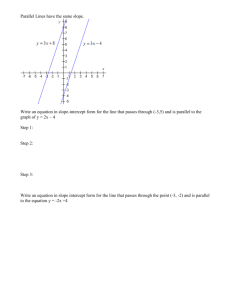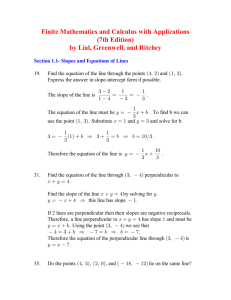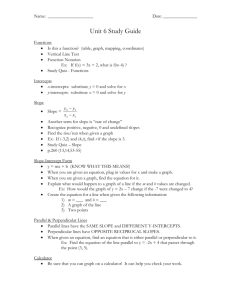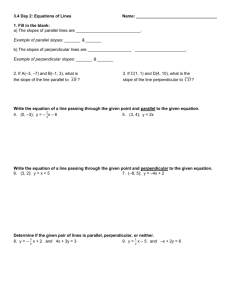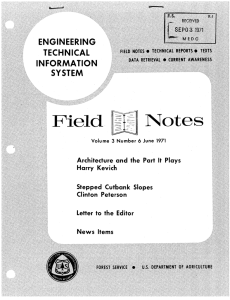File 4.5a notes ppt
advertisement
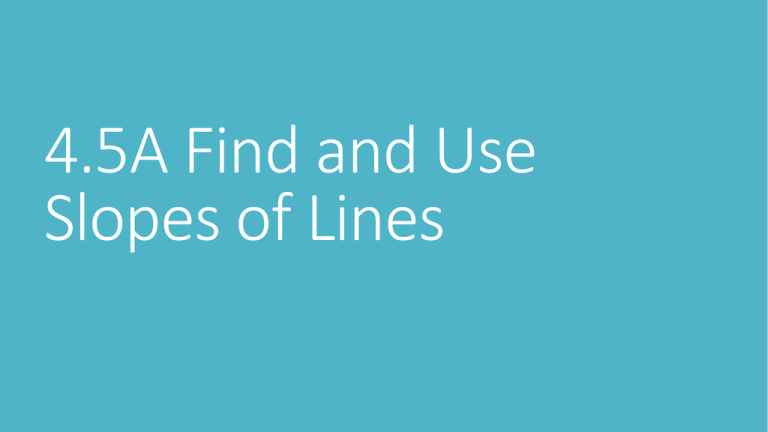
4.5A Find and Use Slopes of Lines Recall: The slope of a non-vertical line is the ratio of vertical change (rise) to horizontal change (run) between any two points on the line. Slope is rise over run: 1 2/8 = 4 Up 2 Right 8 𝑦2 − 𝑦1 𝑚= 𝑥2 − 𝑥1 𝑚= 4 −2 5 −−3 2 8 = = 𝟏 𝟒 Slope is rise over run: −𝟐 -4/6 = 𝟑 𝑦2 − 𝑦1 𝑚= 𝑥2 − 𝑥1 𝑚= down 4 Right 6 −4 −0 2 −−4 = −4 6 = −𝟐 𝟑 Slopes of Intersecting Lines - The steeper line has the slope with _greater absolute value___. Slopes of Parallel Lines – In a coordinate plane, two non-vertical lines are parallel if and only if __they have the same slope_____________________________ Any two __vertical__ lines are parallel. Slopes of Perpendicular Lines – In a coordinate plane, two non-vertical lines are perpendicular if and only if the product of their slopes is _-1__ (or their slopes are _negative reciprocals__). Vertical and horizontal lines are perpendicular. 𝑚𝑗 = 0 −6 2 −0 = −6 2 = −3 1 −6 −5 𝑚𝑘 = = 0 −−2 2 0 −5 −5 𝑚𝑛 = = −4 −−6 2 K and n are parallel (they have the same slope) J is steepest (it has the greatest absolute value) Example - What is the slope of any line perpendicular to the line through (-2,5) and (3, -1)? m= −1 −5 3 −−2 = −6 5 Perpendicular Slope 5 6 Example - Given points A(1,-4), B(-1,2), C(4,2), and D(5,-1), use slopes to determine whether AC ⊥ DB. 𝑚𝐴𝐶 = 2 −−4 4 −1 6 3 = =2 𝑚𝐷𝐵 = −1 −2 5 −−1 −3 6 = = 1 − 2 The slopes are negative −1 reciprocals (2 * = −1) so 2 the lines are perpendicular. 𝑚1 = 6 −−2 5 −1 8 4 = =2 𝑚𝑝𝑒𝑟𝑝𝑒𝑛𝑑𝑖𝑐𝑢𝑙𝑎𝑟 1 =− 2 Example - Line q passes through the points (1, 2) and (-4, 5). Line t passes through the points (-2, -1) and (10, 7). Which line is steeper, q or t? 𝑚𝑞 = 5 −2 −4 −1 𝑚𝑡 = 7 −−1 10 −−2 = 3 −5 = 8 12 = 𝟑 − 𝟓 𝟐 𝟑 = -.6 = = . 𝟔𝟔𝟔𝟕 T is steeper because it’s absolute value is larger.
